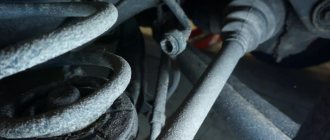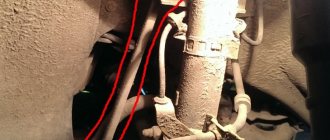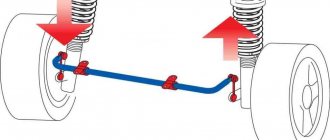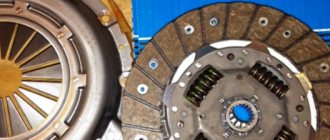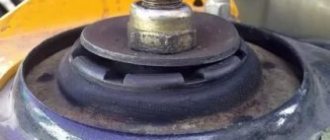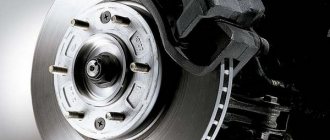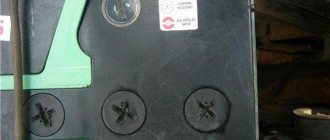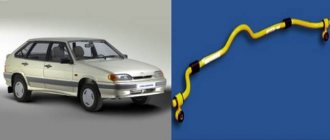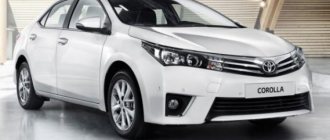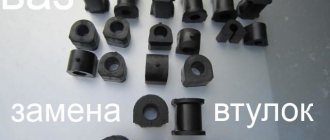Design and principle of operation
The stand is a rod with a length of 5 to 20 centimeters. The rod has hinges at both ends for mobility. The following options can be installed as hinge joints:
- two ball joints;
- stabilizer joint and bushing;
- two bushings;
- on one side there is a hinge, and on the other there is a thread.
As a rule, hinge parts are welded to the rod at a right angle (90 degrees). At the point where the tip attaches to the metal rod, it has a neck (thin end). This was done on purpose, that is, they weakened the structures in this particular place, so that if the permissible maximum loads were exceeded, the device stand would break in exactly the thinned place. This method can be called a mechanical fuse. If the strut had broken in any other place, it could have pierced the bottom of the car, causing harm to the driver or passengers.
This thoughtful design of the racks allows you to protect yourself from unnecessary problems. There is no need to complain that the racks often fail; they are specially made not too thick. Non-original racks are often larger in diameter than the original ones. They will last longer, but safety in this case is reduced.
The most popular type of racks are racks with ball joints. A device of this type of rack includes a steel ball pin and a plastic seat with a lubricant that has special temperature and dynamic characteristics. A metal or plastic cap is pressed onto the top of the finger.
To protect against dust getting into the hinge joints, sealed rubber boots with lubricant are always installed. Such a simple part as a boot significantly increases the service life of the device and the moving mechanism protects against loss and contamination of lubricant. The main property of the lubricant for the hinges under the boot is frost resistance so that it does not thicken in severe frosts.
To better understand how stabilizer struts work, you need to understand that the struts are not rigidly connected to the stabilizers, that is, they have some mobility relative to each other. During a turn, the car begins to tilt (natural roll), and at this time only forces act on the car body, and forces act on the suspension, which try to straighten the body. If the roll force is much greater, then there is a risk of breaking the associated parts: the stabilizer and the hub eye. It turns out that the stabilizer link is a damper that equalizes oppositely directed forces. But, since the force that wants to overturn the car (during a sharp turn) and the force that is against it, both put pressure on the stabilizer bar, which is why the hinge joints of the strut are gradually destroyed.
There are manufacturers who make stabilizer struts with self-adjustment. For example, on the Nissan Patrol GR (Nissan Patrol GI ER) an electronic anti-roll bar is installed, that is, the electronics can turn off the stabilizer.
There are also cars, often SUVs, in which the operation of the stabilizers is regulated by an electronic control unit (ECU).
Malfunctions of the stabilizer struts
Malfunctions can be identified by knowing the symptoms and signs of malfunction. If problems occur in the operation of the stabilizer struts, the following symptoms appear:
- There is a characteristic knocking noise when driving on rough roads. This symptom occurs on machines that have racks with ball joints. For example, the stabilizer knocks when moving over a speed bump (an artificially created unevenness in the road to reduce speed).
- While driving on a flat road, the car pulls to the left and then to the right.
- During a normal turn, the car rolls (tilts) more than it was before.
- There is a lateral swaying of the car body when driving on a flat road.
Causes of breakdowns of stabilizer struts
The most vulnerable element in this assembly is the hinge joints. The reasons may be the following:
- The boot has ruptured, causing dust to get onto the lubricant and into the joint itself.
- The ball pin race has worn out. In this case, the ball pin dangles in the seat.
The influence of stabilizer struts on movement
From all of the above features, we can freely say what the stabilizer struts influence. The driver must first of all understand how to behave when cornering and generally drive correctly.
Car suspension
Stabilizer struts affect the following points:
- movement of the vehicle in general;
- without them it is impossible to operate the machine;
- there is a risk of getting into an accident;
- constant noise.
Signs of malfunctioning stabilizer struts
If the struts are worn out, the car will not be able to protect itself from skidding, since the hinges at the ends will not perform their functions. The driver gradually begins to feel a less smooth movement, there will be a feeling of riding on an ironing board. It will subsequently seem so unstable that the car enthusiast will be afraid to get behind the wheel. Quickly worn-out parts are a sign of careless driving, and when the struts are almost worn out, you need to hold the steering wheel with even more confidence than when the struts were still in good condition.
suspension arm
In addition to all this, do not forget that they also connect the anti-roll bar to the suspension arm, so it’s simply not possible to drive without struts. They have a fairly low price on the market and, as a rule, one of these is enough for six months of driving. In any case, there must be a component that allows you to do what the anti-roll bar does.
Drifting into a snowdrift
Do not forget about the risk borne by the driver. With worn elements both front and rear, you can drive, but not freely. At the same time, the driver is responsible for his own actions. The likelihood that a car will drive into a pole increases many times over, and in winter almost every driver will be able to visit at least one snowdrift.
When any element of the car dies, it lets you know by making a sound. When a driver is asked the question “what is the effect of the stabilizer struts,” everyone freely answers: “the struts make a rattling sound.”
Knock in the front suspension
Important: If a person experiences discomfort while driving and often skids and hears a rumble, this element definitely needs to be changed. Moreover, they rattle both front and rear, because the struts most often wear out both at once.
How to check stabilizer links?
Hello, dear friends, readers and subscribers of my site, today I’ll tell you about the parts on which the comfort and safety of passengers and the driver directly depends, these are stabilizer struts, how to check their serviceability and replace, if necessary. Ignoring faulty struts leads to an accident and can cost the lives of you and your loved ones.
Even extreme sports enthusiasts, lovers of adrenaline and thrills, very rarely risk their health and life in vain, and you and I are not one of them.
How to determine when it’s time to change stabilizer links
In order to distribute the level of kinetic impact on the suspension, and not subject only its individual elements to special loads, stabilizer struts and bushings are used in any car. Read on to learn how to check the stabilizer struts, as well as how to properly carry out maintenance on the struts and bushings of the stabilizer system.
To get to the stabilizer struts, you will have to remove the wheel. Stabilizer struts, as a rule, are located in different axes of the car, on both axles, and in good condition increase the stability of the vehicle (especially when performing any maneuvers). Simply put, it is this complex design that prevents you from entering a full roll during a turn, or a lateral roll in the event of a rollover. This is the link between the car's suspension and the anti-roll bar.
By themselves, these parts are not too expensive, but their functional significance for the car is extremely high. In technical terms, these structures are not “picky” about constant maintenance and are easily amenable to preventive measures. However, faults that arise, even on a small scale, can cause a lot of problems for drivers. It is important to prevent any malfunctions associated with racks at the initial stage of occurrence in order to prevent the occurrence of emergency situations.
What are they needed for
Stabilizer links are quite simple, but necessary parts of the car. The driving comfort and safety of everyone in the car depends on them and the stabilizer itself.
Through the struts, the stabilizer is connected to the suspension and helps reduce the roll of the car entering a turn and prevent it from rolling over.
Taking into account the fact that stabilizers are capable of fully functioning exclusively in horizontal or close to horizontal planes, this limits the entire design of the car.
To avoid troubles of various kinds, stabilizers, through special struts, are connected to elements of the car suspension - shock absorbers or levers.
It is the racks that work in planes close to the vertical.
There are front and rear racks. As a rule, rear struts are found in cars with independent rear suspension. The operating principle of the front and rear stabilizer struts is the same.
The load that occurs when the car rolls mainly falls on these struts; the strut creates elastic resistance when rolls occur, reducing them, but their wear increases, and it is these struts that have to be replaced more often than others; other parts suffer less.
Each car is equipped with such racks, while the car is new, they do not make themselves felt, however, as the mileage increases, the parts wear out, and racks are no exception; they, like many other spare parts, are elements that are not designed for their entire service life auto.
Even if you ride exclusively on smooth roads and tracks, without potholes and cracks, and do not engage in sharp turns and drifts, as is now fashionable among young people, there will still be wear and tear and replacement of struts will only be delayed for some time.
Yes, a careful driving style affects the performance of struts, prolongs their service life, and other automotive parts; less overload means less wear.
What will the replacement give?
By replacing the stabilizer struts in a timely manner, you get comfortable control, safety, the car gets a smooth ride and avoids skidding to the sides.
If the struts are worn out, you have to lean on the steering wheel when turning and hold the steering wheel tightly while moving in a straight line in order to control the movement, the car can constantly be thrown either to the right or to the left.
This is in good weather, but a slippery track will generally make the already unruly equipment completely uncontrollable, and an accident is inevitable.
I have been observing a similar situation for a long time - as soon as it rains in the city (snow is rare in our country), accidents and traffic jams immediately arise, a slippery road requires increased attention and good handling, and besides, almost no one knows that on a wet and slippery road the brakes the path of any car increases tenfold!
This is in good weather, but a slippery track will generally make the already unruly equipment completely uncontrollable, and an accident is inevitable.
I have been observing a similar situation for a long time - as soon as it rains in the city (snow is rare in our country), accidents and traffic jams immediately arise, a slippery road requires increased attention and good handling, and besides, almost no one knows that on a wet and slippery road the brakes the path of any car increases tenfold!
How to determine such a malfunction
There are several different ways to check stabilizer struts, time-tested by specialists and ordinary amateurs:
- Turning the steering wheel one way or the other until it stops when the car is not moving or is hung on a lift
- Check for beating, squeaking (knocking) and noise, first in motion, then again on the lifting device.
- A noticeable increase in roll when cornering, and the appearance of grinding and other unpleasant sounds already suggests that the stabilizer links need to be checked.
- Removing and diagnosing rods manually.
Removal for final inspection
To check manually:
- The rack needs to be unscrewed; to do this, in the inspection hole, with the help of a jack, the car is raised from the desired side, supported by the “goat”, and the wheel is removed.
- Supporting with one jack is dangerous for life, it can come off or fall unexpectedly!
- You cannot place bricks, they are fragile, the support is not reliable
- Building a pyramid from planks is also risky, it can collapse, if there is no “goat”, then use a large solid and durable wooden block for insurance.
- The nuts from unscrewing are secured with cotter pins; remove the cotter pins.
- We unscrew the nuts and knock out the rod fingers, only you need to hit the rod fingers through a board or a soft metal gasket, otherwise you will ruin the thread.
Stabilizer struts look about the same, only the pins can be longer or shorter and the length of the lever is longer or shorter, and the pins can also be collapsible or non-collapsible.
Having removed the rack, the fingers are rotated manually; creaking, grinding and jamming means replacement if the rack fingers are not removable.
Ideally, the fingers should rotate with effort, but without jerking, creaking, or jamming; if it dangles too easily, the hinge is broken; also repair, if possible, or replace the entire part.
When the hinge can be disassembled, it is disassembled, lubricated and worn elements are replaced.
Rubber caps are boots that protect the hinges from dirt and dust; torn boots should be replaced, even if everything is fine with the traction.
It turns out to be a manual check, if everything is in order, just screw the rack back, if there are defects, it is better to buy a new one; the rod that needs to be repaired is repaired by purchasing a repair kit.
If you have money, but are too lazy to tinker with the car, go to a service station, they will fix everything, and there is no need to get your hands dirty.
Removing it purely for checking is a waste of time, you need to do this when the symptoms described above occur, when the traction is already on the list of possible causes, we remove it to understand where the malfunction lies.
I was amused by such a widely circulated phrase: “before looking for the cause (before identifying the malfunction), let me explain how to remove the part”, the phrase of a “true master”, maybe let’s, guided by such a wise principle, disassemble the whole machine, and then look for problems!
Now seriously - they always find out the reason first, then they start filming something. The opposite can be done if access to a part suspected of a problem is hampered by another one. Here, indeed, we unscrew the interfering element and check the one that interests us.
That’s all I have, thank you to everyone who is with me, reads me, subscribed to site updates, always happy to share experience, a new useful example, don’t forget about your friends, share the link and news with them, see you soon and no matter what!
Source
Checking the stabilizer struts
Failure of the anti-roll bar affects the vehicle's handling. Therefore, when the first symptoms of a malfunction appear, a check must be performed.
If the diagnostics show that the rack is out of order, then it is necessary to repair it or replace it with a new one.
Determining the malfunction by dismantling the rack
You can check the stabilizer link for malfunction by removing it from the car. This can be very difficult to do due to corrosion and sticking of threaded connections, so identifying problems with the knuckle by removing it from the machine is a last resort.
Removing the rack from the car
The lubrication should be checked on the dismantled rack. It should be in sufficient quantity and not contain any liquid or debris.
Anti-roll bar link with boot removed
Before completely removing the stabilizer link from the car, it is recommended to carry out diagnostics by unscrewing only one fastener. The knuckle should be shaken from side to side. If a characteristic sound occurs, the car owner will know exactly which side of the rack has become unusable.
Roll on a turn. Every driver knows that if the car rolls when turning, then this is a sign of a malfunction. The roll indicates many problems, including a faulty strut. Check the lubrication. To do this, you need to remove the part and unscrew the hinges with anthers. There should be lubricant underneath them. If there is dirt instead, the rack must be replaced.
Key words: Signs of malfunction, checking the stabilizer link, machine repair, Causes, breakdown, symptoms, how to check
It is necessary to know the signs of a malfunctioning stabilizer link, since the structural fasteners and the strut rod itself have subtle weak points that are provided for safety reasons. Where strut components are thinned, breakage or deformation may occur due to increased load on this suspension element.
The stabilizer is designed to increase the stability of the car while driving, as well as reduce the possible roll of the car when entering a turning zone or making sharp maneuvers. Therefore, stabilizers on independent suspensions on both axles are designed to prevent lateral roll of the vehicle and, as a result, its rollover.
To give mobility to the joint between the car suspension and the strut, hinges are used. This connection is hermetically protected by special anthers, inside of which there is a lubricant that is capable of maintaining the properties of the parts at different temperature conditions. Failure of stabilizer elements can lead to failure of other suspension elements, which will entail costly repairs. Therefore, this component of the car requires periodic inspection.
Details about the malfunction
Signs of a faulty stabilizer link
It is quite easy to determine, especially while driving over uneven roads and potholes. The first thing you should pay attention to in this case is a knock that appears under the hood or in the rear of the car. If at speed the car skids, it is carried off track, especially when the steering wheel is released, and you constantly have to level the car, then this is also one of the characteristic signs of a breakdown.
When entering a turning zone
, the car may experience a strong roll on one side, depending on the direction of travel. An external inspection of the racks may not always reveal their breakdown. Another characteristic sign of a breakdown is excessive rocking of the car during braking, as well as when entering a turn in the absence of visible damage to the strut.
How to determine a breakdown?
To check the stabilizer struts, you can use a fairly simple method, for which you need to free up the space in the wheel niche by completely rotating the wheelset. Then you need to grab the stabilizer strut with your hand and strongly shake it from side to side.
In case of play and knocking
It is urgent to replace the part. This is due to the fact that the mechanism experiences heavy loads while driving, so this should not normally occur. To check, you can drive the car into an inspection hole, or check it using a lift.
The machine is installed on jacks, then the fixing nut is released and the stabilizer link is released. Now the mechanism needs to be loosened well. If there are characteristic beating sounds and free movement of the hinges, there is a need to replace or repair them.
Loose hinges can also be determined using a pry bar. To do this, you need to swing the stand in different directions at the attachment point. If they loosen without much effort, then the part has become unusable and requires replacement.
The fault can also be determined tactilely. To do this, you need to climb into the inspection hole and ask someone to loosen it. In this case, it will be possible to accurately determine where the sound signaling a breakdown is coming from, and the fault itself will be felt when touching the mechanism.
As a rule, most often the bushing wears out or the suspension ball element breaks. Therefore, repairing the mechanism comes down to replacing them.
The second strut can also be checked by rocking the car
. This must be done by loosening the transverse stabilizer. A knock in the mechanism will indicate the need to replace the strut and indicate signs of a malfunction of the stabilizer strut.
Failure of the anti-roll bar affects the vehicle's handling. Therefore, when the first symptoms of a malfunction appear, a check must be performed.
If the diagnostics show that the rack is out of order, then it is necessary to repair it or replace it with a new one.
Symptoms indicating a malfunction of the racks
The following symptoms indicate the need to check the stabilizer struts for functionality:
- a knock or other extraneous sound is heard from the wheel arch;
- when cornering, excessive roll occurs;
- the car becomes very loose when driving over uneven surfaces;
- The car sways during intense acceleration or braking.
All of the above symptoms only indirectly indicate the presence of malfunctions with the stabilizer link. Therefore, to more accurately identify problems, additional diagnostics are required, which is not difficult to do on your own, and if problems arise, you can always watch a thematic video.
What to do if the stabilizer link starts knocking: is it possible to drive?
How to understand that it’s time to change the armor wires in your car
The main sign of a malfunction is the sound of the struts, while a number of additional signals are observed:
- constant body roll when turning;
- spontaneous change in the trajectory of the vehicle while driving over uneven surfaces;
- when driving, you can hear the stabilizer joints rattling;
- During acceleration or braking, the suspension feels loose.
If the stabilizer bar is knocking: is it possible to drive? This is the question that worries most car owners. Let us emphasize once again: it is strictly not recommended to operate a vehicle on which the stabilizer struts are damaged, since such a malfunction causes a decrease in controllability, and this can provoke a serious accident. In addition, the constant knocking of the suspension while driving distracts the driver all the time.
The deterioration of the hinges located inside the stabilizer struts is a progressive defect, since at the initial stage the malfunction does not manifest itself in anything, and then, as wear progresses, extraneous noise and body roll occur while driving. As soon as the first symptoms are noticed, you must immediately go to the nearest car service center to diagnose the condition of the suspension elements (in particular the stabilizer struts), or perform independent troubleshooting.
Important! To diagnose the condition of the suspension, it is necessary to lift the car on a lift, or jack it up on all sides, since under the weight of the vehicle it is not always possible to detect play in the hinges. Can stabilizer struts make knocking noises when they are in good condition? Naturally - yes
The cause of extraneous noise is incorrect adjustment of the stabilizer elements, which must be eliminated without fail.
Can stabilizer struts make knocking noises when they are in good condition? Naturally, yes. The cause of extraneous noise is incorrect adjustment of the stabilizer elements, which must be eliminated without fail.
To carry out the diagnostic process, you may need the help of a friend and the following set of tools:
- jack - for lifting a vehicle and inspecting and repairing suspension parts. Please note that safety regulations prohibit performing any work when the car is jacked up without placing appropriate supports under its frame;
- shoes for fixing wheels;
- frame stands;
- It would be nice to have a car stethoscope, since when the suspension is unloaded, extraneous noise from its elements can only be heard with its help.
Backlash control
You can check the front stabilizer link for play by turning the wheel out. To diagnose the absence of problems with the back knuckle, you will need to install the machine above the inspection hole. You can check the malfunction of the stabilizer link by following the instructions below.
- Grasp the center of the rod with your hand.
- Shake the knuckle with a little force.
- The presence of any play is unacceptable and indicates that the stabilizer link must be replaced.
- Ask an assistant to rock the car. In this case, you should try to move the stand with your hand. The appearance of knocking and free movements indicates that the knuckle has lost its functionality.
When should you change?
Racks need to be changed periodically. How often depends on your driving style. Some motorists are accustomed to driving along the road for their own pleasure, without noticing potholes, sharp turns, speed bumps, while others monitor the road more clearly, and accordingly, their racks last much longer.
Stabilizer link wear
But how can you determine if a stabilizer link is faulty? There are several methods that mechanics recommend, and many drivers have tried them. These methods are considered the most correct, they include:
- noise check;
- turning the steering wheel all the way;
- strong roll when turning;
- checking lubrication.
Car enthusiasts recommend using all methods in turn. To some extent, this list is also an algorithm for identifying a malfunction. If you try all four methods, the driver can find out for sure whether the struts need to be changed.
Rack Installation
Like many other important parts of a car, the stabilizer bar makes noise because it wants to, but cannot, perform its functions. It cannot be compared with anything - a kind of roar and grinding sound at the same time, which is noticeable precisely when cornering. The sharper the turn, the louder the noise. Most drivers check the malfunction in this way, since this is more likely not a method, but a sign of a breakdown.
Car skidding
Also, while driving, the driver may feel discomfort. Of course, it will be felt during all the same turns and bumps. Experienced drivers know that if it skids, there is a problem in stabilizing the movement, which means the struts need to be changed. In fact, this method never tells for sure, since the skid begins gradually and sometimes the driver simply does not notice the effect until he hears this very roar.
Visual check of the condition of the racks
You can more accurately determine the condition of the stabilizer struts by visually inspecting them. The easiest way to identify a bummer. Car owners usually encounter this situation either after long-term use, or if the wheel gets into a deep hole or other uneven road surface.
By checking the condition of the rubber elements of the stabilizer link during a visual inspection, you can also identify a malfunction. A bushing or boot that has cracked due to aging indicates that the life of the knuckles has been exhausted. In normal condition, the rubber should be elastic, without tears, signs of abrasion or other damage.
Detailed rack inspection
The most complete check of the stabilizer link can be performed by removing it from the car. Car owners are not advised to frequently resort to removing the knuckles, since their fastenings are exposed to an aggressive external environment and often become tightly stuck.
After removal, you should carefully inspect the rubber elements. They very often lose their elasticity, become discolored or have mechanical damage.
When diagnosing stabilizer struts, the design of which includes hinges, it is necessary to remove the boots and check the condition of the lubricant under them. The presence of moisture and various debris is unacceptable. At the same time, you should also inspect the hinge. There should be no traces of corrosion or mechanical damage.
Rack repair
Many car owners do not recommend repairing the strut, since after restoration it can rarely last for a long time. Despite this, there are many ways to restore the functionality of your knuckles. One method is given below.
- Remove the boot.
- Clean out the old grease and add new one.
- Squeeze the joint in a vice in the direction shown in the photo.
An alternative repair option is given below.
- Remove the boot.
- Rinse with kerosene.
- Tap the body with a core.
A more complex method for repairing a rack is shown below.
- Drill the side of the hinge.
- Insert the grease fitting.
- Fill with lubricant.
If the rod breaks, there are also methods to solve the problem. If you have welding, you can use it to fasten the two ends together. An alternative is to cut threads and use special connectors.
Source
Using special equipment to monitor the condition of racks
There is practically no separate special equipment for diagnosing exclusively anti-roll bar struts. Service station technicians often suggest testing on a vibration stand. In this case, you can only indirectly find out about the presence of problems with the knuckles.
Inspection of the stabilizer struts directly by a technician allows you to determine the presence of malfunctions more accurately, compared to a vibration stand. Therefore, experienced car owners recommend contacting good specialists, regardless of whether they have special equipment for diagnosing stabilizer struts.
Checking new racks
When purchasing new racks, they also need to be checked for functionality. This is due to the presence of a large number of defects and fakes on the market. The table below contains a list of criteria that you should pay attention to when checking the purchased spare part.
Table - Criteria for checking new stabilizer links
| Criteria to pay attention to | Note |
| Package | It is recommended to check all insignia against counterfeits using information from the manufacturer’s official website. This will help you avoid purchasing counterfeits. |
| Measure all lengths and thicknesses | Many budget manufacturers violate production technology, which leads to differences in sizes. By purchasing such a spare part, the car owner will not be able to install it in its original place and the rack will need to be modified. |
| Availability of lubrication | The durability of the strut joint directly depends on the amount of lubricant. Many manufacturers use very little lubricant, which sticks to the boot. Running the hinge “dry” quickly disables it. Therefore, after purchasing a new product, you should remove the cuff and add lubricant if necessary. |
DIY stabilizer link replacement
Removing old ones and installing new ones is quite possible for an ordinary car enthusiast without any special plumbing skills. They always change in pairs. It is worth noting that your car may not have rear struts (as well as the stabilizer itself). On some models, their function is performed by other suspension parts.
Replacement of the rear stabilizer struts is carried out as follows:
After driving a couple of hundred kilometers, you must definitely check the fastening nut and, if necessary, tighten it.
Replacement of the front stabilizer struts is carried out by analogy. Sometimes brake hoses can get in the way and will have to be removed from the mounting brackets for a while.

